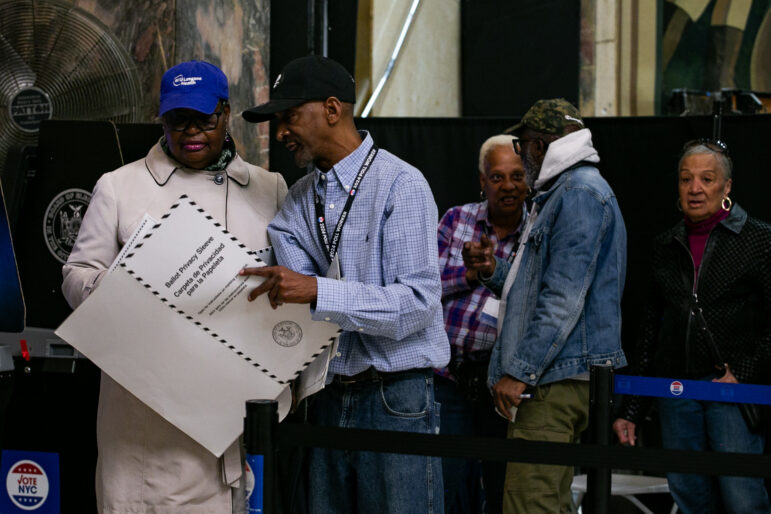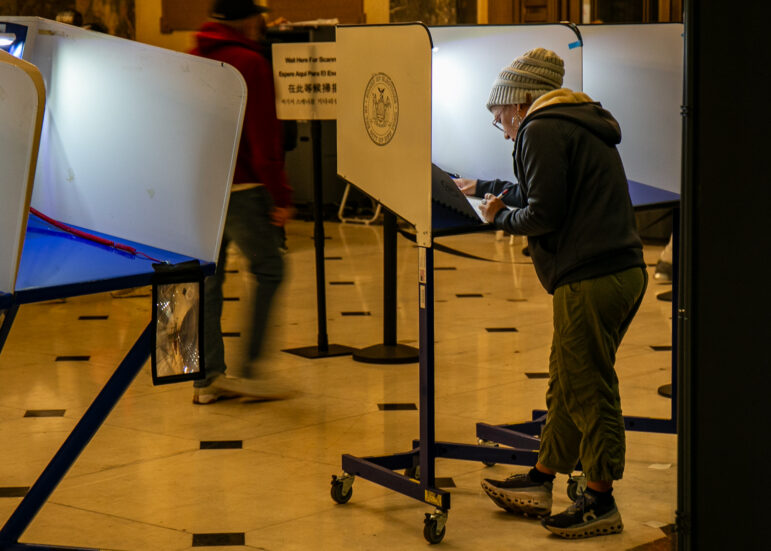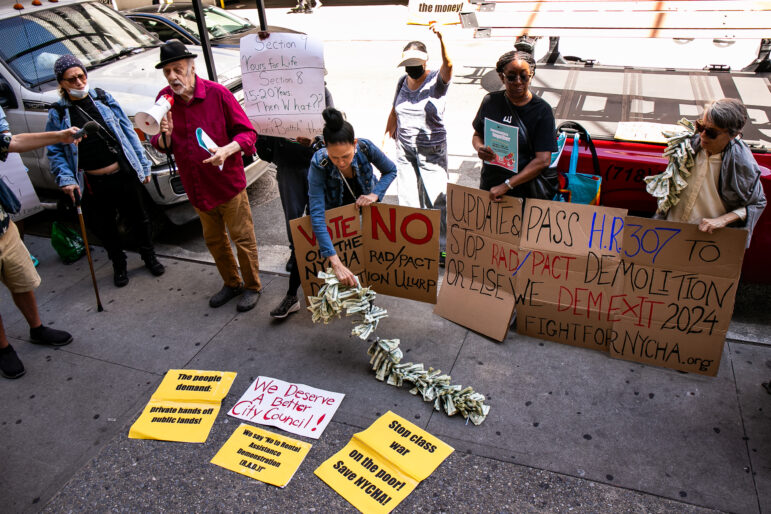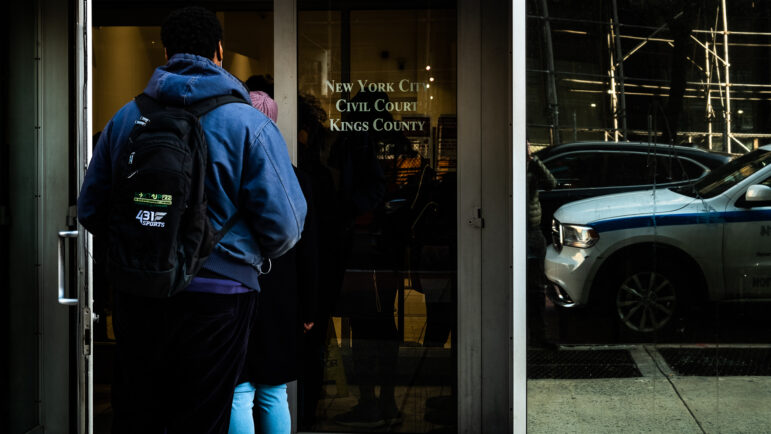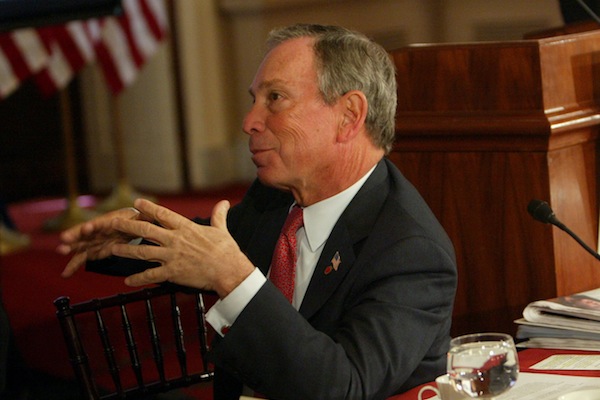
Photo by: City Hall
The mayor promised to shift the orientation of the city’s policies away from crisis management and toward attacking the causes of homelessness. He also promised to reduce shelter populations dramatically.
Some weeks after taking office, Mayor Bloomberg and his then homeless services commissioner, Linda Gibbs visited the Prince George. Located off the upscale 5th Avenue in Murray Hill, the Prince George is a 416-unit, low-income housing building for former street homeless people and New Yorkers living with HIV and AIDS.
The trip was part of an effort to get the mayor and his team up to speed by meeting with advocates and field professionals. A first, formal meeting gathered about half a dozen advocates and a similar number of commissioners, all direct or potential actors in the battle against homelessness — homeless services, human resources, children resources and housing agencies. This first meeting was followed by a series of smaller, sometimes one-on-one tours around specific issues so the mayoral team could learn in a hands-on manner.
Among the advocates at these meetings was Maureen Friar, then the executive director of the Supportive Housing Network of New York, representing supportive housing providers across the city. Friar remembers a friendly administration looking for resolution. “Bloomberg brought in people interested in making things happen,” said Friar, who was behind the Prince George outing. “There was a real openness and willingness to learn.”
Building a blueprint
Friar and a group of other advocates had been working on The Blueprint to End Homeless in New York City a book-length plan on how to tackle the problem of homelessness with more permanent housing solutions and a range of onsite services. Gibbs and her team were handed an outline with key recommendations, which to the delight of Friar, became the basis for a citywide campaign.
About six months after the elections, Gibbs decided to make a blueprint of her own. The commissioner asked three key players to coordinate the effort: Lilliam Barrios-Paoli, chosen for her long-lasting involvement in homeless advocacy; then mayoral Chief of Staff Peter Madonia, needed for his links to government officials; and William C. Rudin, a longtime Bloomberg friend, real-estate mogul and chairman of the Association for a Better New York, a powerful coalition of business, non-profit and political leaders.
The trio then reached out to more than 70 other participants encompassing a wide range of industries—shelter services, homeless advocacy, supportive housing, children services, mental health, the judicial system and real estate. Over a period of five months, between November 2003 and April 2004, members of sub-committees regularly met for brainstorming sessions at City Hall.
The task-force recommendations shaped Uniting Beyond Shelter: The Action Plan for New York City, a 40-page document detailing a nine-point strategy to implement over the course of the following five years.
Following the release of the document was Bloomberg’s official unveiling on June 12, 2004. Revolutionary in its comprehensiveness, the plan required the participation of many agencies. Until then the homeless issue was divorced from affordable housing, healthcare or the judicial system.
“That showed a lot of guts,” says Main. “It seemed to be the thinking of a business person, interested in solving problems rather than muddling through.”
The scope and challenge of the task Bloomberg had assigned to his administration was unparalleled. Nothing had been left out, from prevention to interagency communication and transparency; the plan even had its own URL, where the administration’s progress would be updated and could be monitored. More impressive, perhaps, the Bloomberg administration aimed to achieve its robust goals twice as fast as any other city that had targeted steep reductions in homelessness.
Early successes
The implementation of the plan started astoundingly well. Within months, the Bloomberg administration shut down the overcrowded Emergency Assistance Unit and opened a luxurious-looking building in the South Bronx to welcome new homeless families, launched a pilot homeless prevention program in six of the neediest communities in the city and got state approval for a new rental assistance program to help people move out of the shelter faster.
In the meantime, the Department of Housing Preservation and Development was busy working on the mayor’s affordable housing plan, launched the year before, which aimed to build or preserve a total of 65,000 affordable housing units in the next five years. In 2006, the mayor increased the goal to 165,000 units and the timetable to 10 years. It was, the administration said, the largest municipal affordable housing effort in the nation.
A number of these swiftly implemented measures had a significant and long-term impact on homelessness in the city.
One of the most successful initiatives was the administration’s support for community-based organizations working with chronically homeless New Yorkers—the so-called “street homeless,” who are not in city shelters. Since 2005, the city has conducted a one-night census of visible street homeless. Between 2005 and 2009, the population was cut by nearly half, decreasing from 4,395 to 2,328 individuals.
“It’s in large part a result of the Bloomberg administration’s focus on this population and the collaboration between city and nonprofits to use new engagement tools to bring folks inside,” explains Brenda Rosen, the executive director of Common Ground, one of New York City’s major actors in street homelessness. In this field, New York is today regarded as a champion. (Last year, street homelessness numbers were on the rise again with more than 3,200 individuals spotted in the streets by the survey’s volunteers.)
Bloomberg’s homeless prevention initiative, HomeBase, also thrives to this day. The Department of Homeless Services added geocoding to its intake tracking system to decide on six “hot spots,” with particularly high shelter demand. The program offers counseling to people who are falling behind on rent, or are otherwise at-risk of becoming homeless, like those living doubled up. And as long as a client can prove they will be able to afford their rent in the future, HomeBase caseworkers will help them come up with the amount they need to bridge a cash-flow gap, up to $3,000.
In 2010, HomeBase was expanded to the rest of the city and its mission broadened to include the rapid re-housing of homeless families placed in hotels financed by homeless services.
According to DHS’s own recent reports, more than 90 percent of the thousands of people HomeBase helps each year have avoided evictions. This figure was called into question by a number of experts, who wondered how the city could know exactly how many HomeBase clients would have ended up homeless if they hadn’t had access to the program’s services. “It’s a controversial question, you can never convincingly answer this,” says Columbia’s O’Flaherty.
The city actually attempted to provide a solid answer, in a rather unsettling way. In 2010, a study monitored 400 households seeking counseling from HomeBase caseworkers. While half of them were given the help they were longing for, the other half was denied any assistance for the next two years. The point, DHS explained, was to compare the rate of homelessness between the two groups. According to Coalition for the Homeless senior policy advisor Patrick Markee, the use of such an initiative itself cast doubt on the city’s claims of success.
Few deny that HomeBase brought some relief, part of an 18 percent drop in the homeless shelter population between 2004 and June 2007.
But then the positive moves by Bloomberg’s homelessness team began playing out against the backdrop of a souring economy and problems with other aspects of the mayor’s policy.
In various combinations, these not only prevented the mayor from the policy achievement he targeted in 2004, but created a deeper homelessness crisis than existed when he proposed his bold plan.
Continue reading:
PART FOUR: As Homeless Numbers Rose, Clashes Over Policies
The city and advocates argued over a series of issues. But they mostly joined forces to defend a crucial state program torpedoed by the state.



